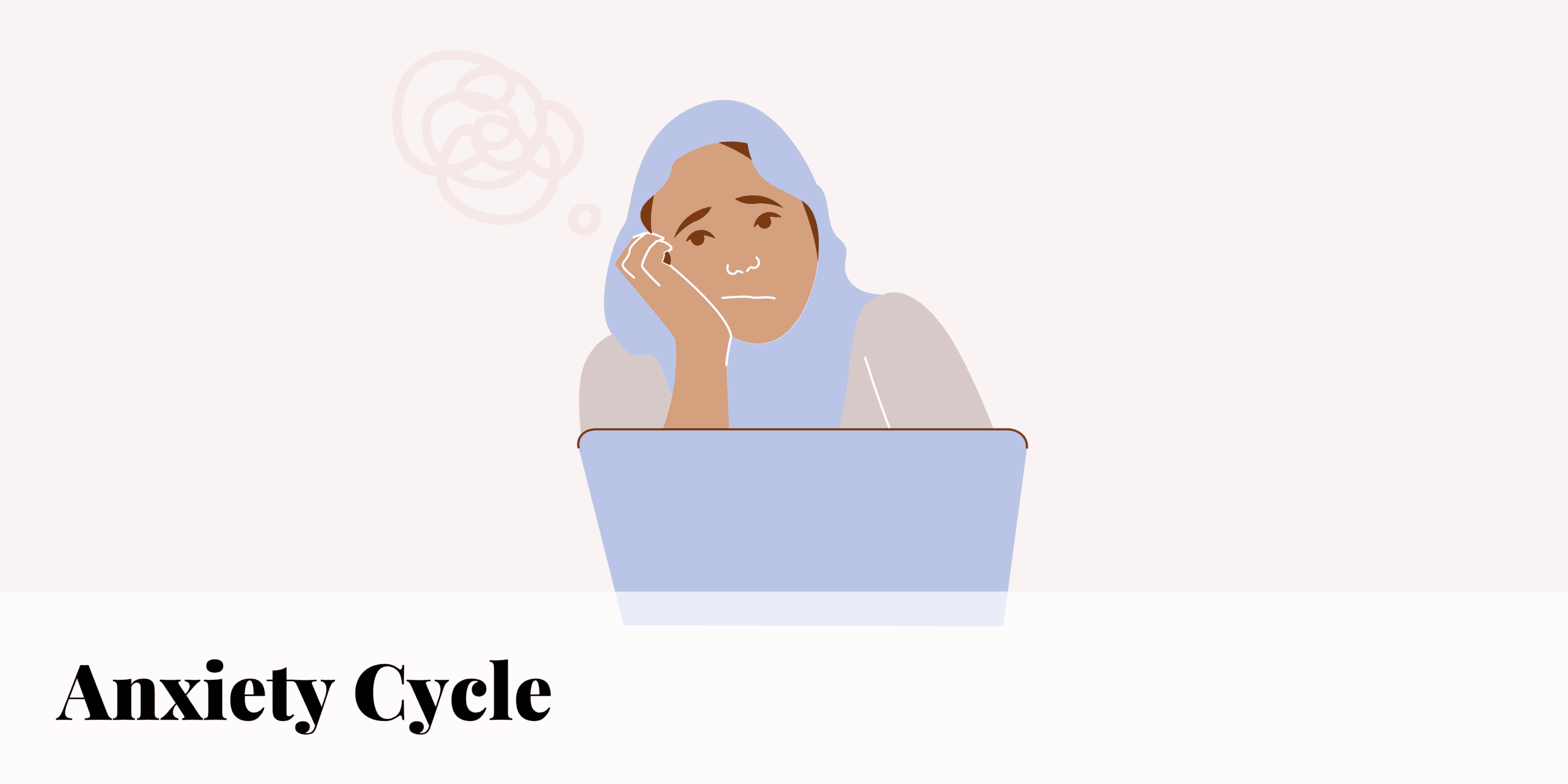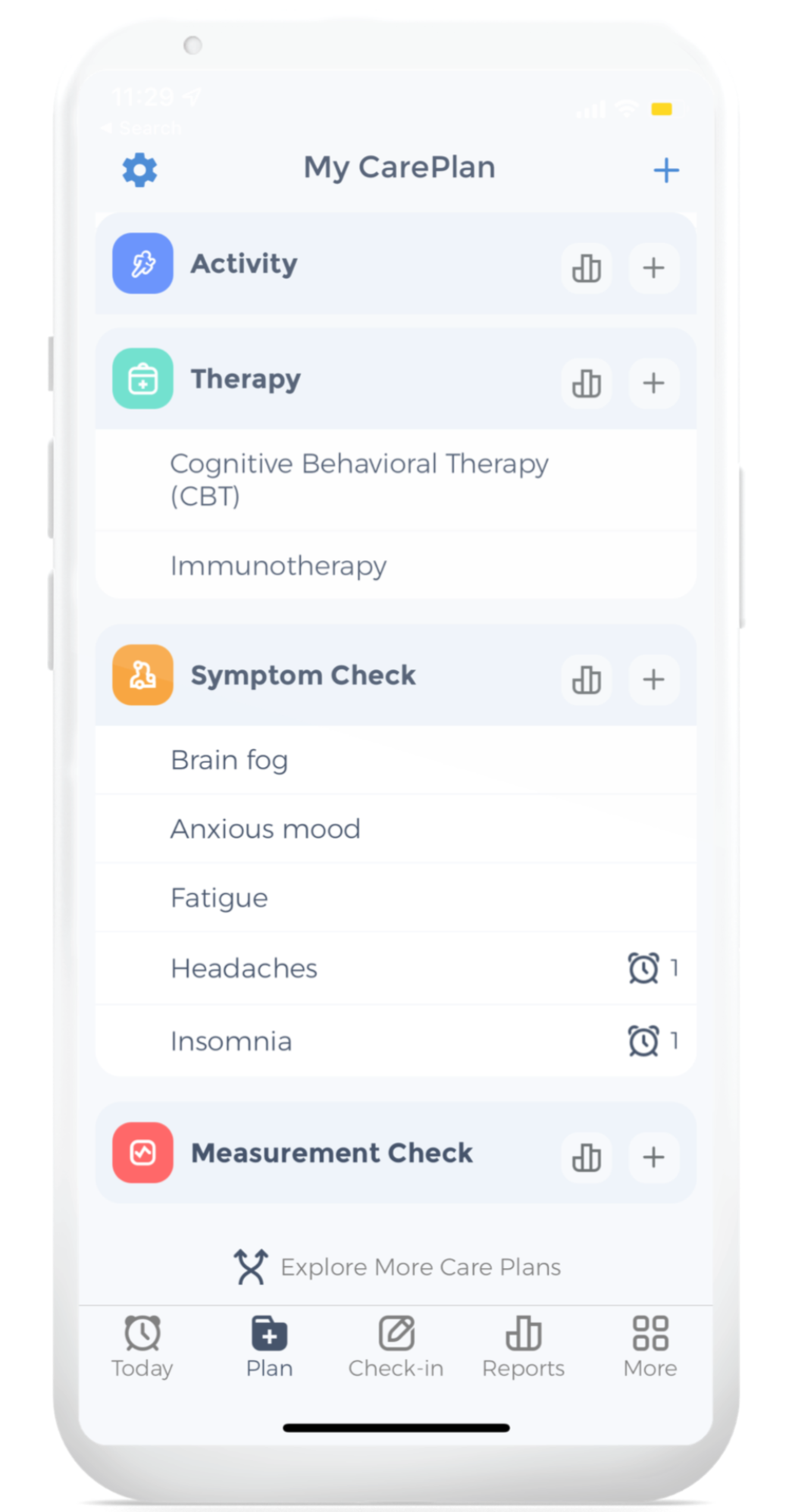
The cycle of anxiety is a heavy burden that many face worldwide. Anxiety can be described as worrying about a potential threat and trying to cope with a future event that you think will be negative. When you notice your anxious symptoms, you start to believe you can’t cope with the symptoms, thus becoming even more anxious. Various factors in today’s society elevate symptoms of anxiety, leading to the cycle of anxiety. By being aware of its symptoms and learning ways to manage it, you will be able to not only break out of the cycle of anxiety but live a positive lifestyle.
This article will provide you with resources to identify what the cycle of anxiety is, the types of anxiety that are related to the cycle of anxiety, and how to break this cycle.
An Overview of Anxiety
Anxiety is a natural response produced by the body when encountering stress. Anxiety is best described as a feeling of fear regarding one’s future. Albeit being a normal and even healthy reaction, when an individual regularly feels disproportionate levels of anxiety, it might be categorized as a medical disorder.
Evolutionarily speaking, when humans were approached by predators or encountered danger, alarms were set off in the body allowing for rapid action. These alarms consisted of an elevated heartbeat, perspiration, and increased environmental sensitivity. This reaction occurs due to a rush of adrenaline, a hormone responsible for the fight-or-flight response which allows humans to confront or flee from potential threats to safety. Although humans in the modern world do not commonly face stressors such as the ones mentioned above, even mild stressors may elicit an anxious reaction.
What is the Cycle of Anxiety?
The cycle of anxiety consists of four stages: feeling anxiety and wanting to deal with it, attempting to avoid the situation, feeling a temporary sense of relief, then returning to a state of heightened anxiety. Many are caught in this cycle without even knowing it. Let’s first take a look at the various types of anxiety and how the cycle of anxiety is related to other relevant problems.
Feeling Anxiety
Anxiety is mostly distinguished by worry about a future threat. It involves making an effort to deal with a potentially unpleasant future outcome. Increasing your awareness of potential threat indicators and checking your internal capability to handle dangers are two ways to do this. You feel more nervous when you become aware of your anxious sensations because you believe you can’t handle the issue. This idea starts the first step of the cycle of anxiety.
Avoiding the Situation
It makes it reasonable that you would take steps to lessen your anxiety if you are experiencing or anticipating experiencing anxiety. Sometimes people will completely ignore the feared circumstance in an effort to lessen their anxiety. Due to the fact that you have avoided creating a stressful scenario for yourself, the anxiety is immediately reduced. However, while avoidance reduces anxiety in the near future, it actually increases anxiety over time. Not confirming your awful predictions of what can occur and constantly checking your surroundings for danger signs and safety signals leads to greater problems in the long run. Your anxiety might grow as a result and spread to other circumstances.
Temporary Relief
Many people utilize “safety behaviours” or implicit avoidance in addition to avoidance to assist them to deal with worry. Some of these include using the medicine, feeling secure with your device, always having a route out of potentially stressful circumstances, or having someone nearby. When you become reliant on someone, it might be more distressing if they suddenly disappear. This is comparable to ignoring the circumstance entirely.
Although the temporary relief as a result of avoiding or using safety behaviours is sufficient to serve you in an instant, it may not always be helpful in the long run. Gradually approaching fearful circumstances is a crucial step in breaking the cycle of worry. By doing this, you will feel more confident, which will help you feel less anxious and enable you to participate in circumstances that are significant to you. Some would advise you to face your worst fear head-on and put it behind you. However, a lot of individuals favour proceeding gradually. We refer to this as graded exposure.
Heightened Anxiety
There will be a temporary rise in anxiety when you gradually face frightening circumstances. This is common; everyone has anxiety while facing their fears. The most crucial thing to keep in mind is that you may develop alternate abilities to avoid safety behaviours. Fast, shallow breathing is frequent with anxiety, which adds to the physical symptoms of anxiety. You may lessen your anxiety by controlling your breathing and employing relaxation and soothing practices. Anxiety is accompanied by a variety of unpleasant ideas, such as the sudden want to flee the setting. You may have less anxiety if you learn to counter these negative ideas with rational ones.
Types of Anxiety
Morning Anxiety
One of the most common types of anxiety is morning anxiety. Morning anxiety is due to cortisol, the human stress hormone. Cortisol is highest in the morning, especially during the first hour after waking up. Morning anxiety may also be due to what you eat in the morning. Caffeine, sugar and a lack of food may worsen symptoms of anxiety. Furthermore, morning anxiety may be due to going to sleep worried or waking in the middle of the night. Morning anxiety is marked by symptoms of racing thoughts, feelings of restlessness, irritability, fatigue, and nervousness for the day ahead.
Second-Hand Anxiety
Although not an official medical term, second-hand anxiety is commonly reported by many who deal with the cycle of anxiety. Second-hand anxiety or second-hand stress is a neurological phenomenon aligning to the way emotions are spread. When we experience the effects of our own emotions like anger, frustration, and sadness, they oftentimes spill over to those around us. Even the act of simply observing someone expressing anger increases cortisol levels in the body by almost 26 percent! Secondhand anxiety can show up in many ways, including worrying about other people’s problems or rushing because someone else is.
The Cycle of Anxiety and IBS
Although it is not quite clear how anxiety affects IBS, studies show that they can happen together. The most common mental ailment that patients with IBS face is a generalized anxiety disorder. People with anxiety tend to greatly worry about their health, leading to other symptoms such as an upset stomach, muscle spasms, and irritability. There are several theories regarding the connection between anxiety and IBS. One theory is that anxiety may make the body more aware of spasms in the colon, leading to a heightened pain sensation. Another theory is that IBS may be triggered by the immune system, which is affected by stress and anxiety.
The Cycle of Anxiety and the Menstrual Cycle
It is very common to experience a spike in anxiety due to the onset of menstruation. This spike in anxiety is due to hormonal fluctuations. In particular, estradiol and progesterone rapidly decline, leading to symptoms such as anxiety.
The Cycle of Anxiety and Alcoholism
The relationship between alcoholism and the cycle of anxiety is profound. Many people with anxiety disorders self-medicate with alcohol, and this could make the problem worse. The relationship between alcohol and anxiety is bidirectional in the sense that alcohol could produce anxiety, or anxious people could be more likely to drink. Studies have shown that anxiety symptoms sometimes precede problems with alcohol, and alcohol problems sometimes precede problems with anxiety.
Medication Tracking for Anxiety

Often people use over-the-counter or prescribed medications to cope with anxiety. A medication log or tracker is the simplest way to keep track of prescribed drugs. Tracking medication is key to remembering the course of the prescription. Health applications, such as CareClinic, allow you to record everything related to the medication taken, including dosage, instructions, purpose, side effects and physician/pharmacist(s) who prescribed the drugs, together with the necessary contact information (useful for refills).
Tracking your medication intake also forces you to stay organized and in control of your treatments. It increases medication adherence, as you will be able to track the efficacy of your treatment and the impact on general health.
It’s fantastic to have a resource where you can keep track of your whole pharmaceutical history. It is a helpful reference tool that speeds up the retrieval of medical data. Furthermore, by utilizing CareClinic to keep track of your previous and present medications, you will limit the chances of misunderstanding. You will make your therapy run more smoothly, and you will attain your health goals.
How to Break and Control the Cycle of Anxiety?
It is important to understand the main driver behind the cycle of anxiety. Although it may make sense to do things that reduce your feelings of anxiety, it isn’t helpful to outright avoid the feared situation altogether. Even though one may feel a temporary sense of relief from the anxiety, it still doesn’t combat the problem in the long term. An example of this is when a person commits themselves to begin their fitness journey. In order to exercise efficiently, they would have to go to the gym; however, they choose to remain at home because the public setting of the gym gives them anxiety. As a result, you successfully avoid the distress you associate with the gym.
In the short term, you do not feel anxious. However, in the long term, you become even more unwilling to confront anxiety. One continues to believe that emotion is dangerous and should be avoided at all costs. You do not disconfirm your catastrophic predictions about what may happen in the gym. You continue scanning your environment for signals of danger and signals of safety. In this way, your anxiety may increase and generalize to other situations.
Mood & Attention Tracking with Anxiety

One of the most volatile characteristics of anxious minds is their mood. CareClinic app has the feature that will manage records of the patient’s moods. It is a great tool to track and view the fluctuations in their mood daily, weekly, or monthly. How do you do that? Read ahead to know How to navigate through this feature.
Open the app, go to check-in, go to the measurements tab, and find a mood check-in. It is set as a default measurement, so it should appear on the screen immediately. If it does not, go to the ‘plus’ sign on the top right corner and select ‘mood’ from it. You can add attention to your daily measurements in the same way.
In addition to the mood tracker, the app has a symptom tracker where patients can keep an eye on mental prodromes such as mental fatigue, brain fog, depression and many more. This is a useful tool to trace if the symptoms are improving or worsening. Getting a summary of your records is even simpler with the reports that CareClinic provides. It means that the app will give a synopsis of the symptoms that you have been tracking. You can easily record symptoms by following these simple instructions:
- Open the CareClinic app on your phone
- Go to the ‘check-in’ tab
- Open ‘symptoms’
- Add symptoms you want to track
The platform has a feature to add notes and set reminders so that you do not miss tracking your health anymore. You can even set a frequency of the reminders you would like to receive in a day.
One can keep records and map those at intervals to track improvements and any changes. This could be a great tool to manage attention and take necessary steps to improve it based on a weekly or monthly overview.
How to Manage the Cycle of Anxiety?
To break the anxiety cycle, you need to become aware of the cycle. So instead of letting your anxious thoughts and feelings drive your behaviour, you have to slow down your thoughts, feelings, and behaviours. As you learn to experience thoughts and feelings as an observer, you’re increasing your power and decreasing the power a thought or feeling has over you. That will then allow you to consciously choose your behaviours. You need to identify automatic thoughts and core beliefs to change your thoughts. An automatic thought is what you say or think automatically. That thought alone doesn’t inevitably lead to anxious feelings and avoidance behaviours. You need to break your thought down and figure out what else I think leads me to feel anxious.
What about that thought makes me anxious? It’s different for each person and could be related to not feeling like you accomplished enough, feeling like you’ll have let people down. Challenging thoughts can be difficult. This is especially true when our core beliefs have been around for a while. When we challenge thoughts, It’s about thinking realistically based on evidence.
Break Out of the Cycle of Anxiety Today

A great way to monitor your anxiety levels and try to break out of the cycle of anxiety is to create a plan using CareClinic. Track your symptoms by using the symptom tracker on the care clinic app and use the drop-down menu to include any pre-existing symptoms included in the app! This allows you to also add notes to your symptoms about details you believe are important, as well as can help track the frequency of the symptoms. CareClinic has a check-in section that includes diary entries that can help track your journey This allows you to maintain a schedule and record to ensure you are doing your best to help heal your condition.
In today’s society, there are various factors for why many are caught in the cycle of anxiety. It is imperative to understand that by being aware of your anxiety and actively challenging your anxious thoughts, it is possible to break out of the cycle of anxiety.
The cycle of anxiety can be broken! Do not let anxiety take control of your life. It may take time and patience to break out of the cycle of anxiety, but some ways can help speed up the process. One of the easiest ways to track your anxiety symptoms and create a well-thought-out plan is by using CareClinic. CareClinic also provides you with reports to update you on the progress of your journey. This gives you detailed information on your symptom tracking and an overview of the improvement of your health. Get started on your mindfulness journey by downloading the CareClinic app to use features such as its diary and symptom tracker. Managing any health condition means understanding your daily energy levels. If you live with chronic symptoms, the spoon theory pdf can help you plan your days better. This simple concept explains how to balance activities when you have limited energy to work with.
References
- Sanders, K. M., & Akiyama, T. (2018). The vicious cycle of itch and anxiety. Neuroscience & Biobehavioral Reviews, 87, 17-26.
- Taylor, S., Koch, W. J., & McNally, R. J. (1992). How does anxiety sensitivity vary across anxiety disorders?. Journal of anxiety disorders, 6(3), 249-259.
- Hamilton, N., Freche, R., Zhang, Y., Zeller, G., & Carroll, I. (2021). Test anxiety and poor sleep: A vicious cycle. International Journal of Behavioral Medicine, 28(2), 250-258.
- Anxiety – reversing the vicious cycle. (n.d.). Retrieved July 20, 2022, from https://www.healthywa.wa.gov.au/Articles/A_E/Anxiety-reversing-the-vicious-cycle
- Managing the cycle of anxiety. (n.d.). Retrieved July 20, 2022, from https://www.cci.health.wa.gov.au/-/media/CCI/Mental-Health-Professionals/Panic/Panic—Information-Sheets/Panic-Information-Sheet—03—The-Vicious-Cycle-of-Anxiety.pdf


